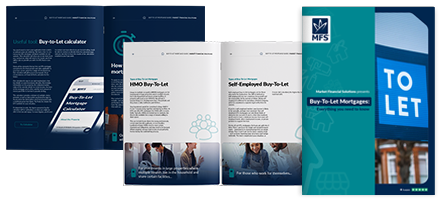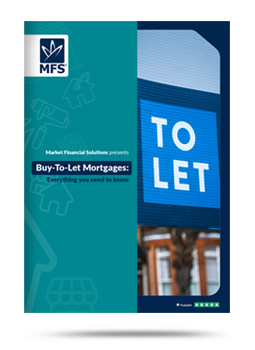Disclaimer
Market Financial Solutions are a bridging loan and buy-to-let mortgage provider, not financial advisors. Therefore, Investors are encouraged to seek professional advice. The information in this content is correct at time of writing.

The property world offers many opportunities for investors. There are fix-and-flip strategies, in which a debilitated property is bought, upgraded, and sold on at a higher price.
Some may invest to convert a property, turning a commercial space into a residential home or vice-versa. Others could require developer exit funding to finalise a development project.
But, when most people think of the property market, they’re likely focusing on the BTL scene. Much of the commentary and analysis on the property market circles around landlords and their tenants, but what exactly does buy-to-let mean, and what is a buy-to-let investment? We will go over the basics and more in this blog.
What Exactly Does Buy-to-Let Mean?
So, what does buy-to-let mean? Well, it refers to the act of an individual or company purchasing a property with the intention of “letting” it out to tenants. When investing in a buy-to-let property, many will utilise a BTL mortgage to do so.
Buy-to-let mortgages are financial products specifically designed for borrowers who want to buy property to rent it out, as opposed to living in it themselves[1]. Most BTL mortgages are interest only[2], often requiring a bigger deposit than what would be needed for a residential loan, and they may have comparatively stricter criteria.
Buy-to-let owners are known as landlords, and the properties they invest in can be broad in scope. But what exactly is a BTL property? Some of the most common examples include residential homes such as flats, or house shares. While rented housing can be found across the UK, they are highly concentrated in and around city centres, where property prices are often high, leaving many with no choice but to rent.
The buy-to-let market is sizable. There are believed to be at least 4.5 million renting households[3] in the UK, and yet we still need more rental stock to meet demand. There are 15 households chasing every rental home in the UK according to Zoopla, with competition pushing up rents to £1,226[4].
Some may assume that the typical renter is young too, possibly flat sharing as a student, or renting out a single flat while they save for a deposit. But, the “typical” profile or demographic is shifting. As costs rise, more people than ever are either being cut off from homeownership, or choosing not to buy at all. Some developers are now targeting middle aged “forever renters[5]”, while the number of 55–64-year-old renters in England has jumped by 80% in the decade to 2023, according to The Mortgage Works[6].
Also, it should be noted that there is a commercial BTL market sitting alongside the residential one. Landlords can purchase a commercial building to rent it out to a business. Common examples include retail stores, offices, and leisure spaces. According to Savills, commercial transaction volumes in the UK market sat at £5.7bn in Q2 2024, while the average prime yield held at 6.07% in June[7].

What Are the Advantages of Investing in BTL?
There are many advantages to incorporating BTL in a property investment strategy. While the market has faced challenges in recent years, rental yields are on the up[8]. Every region in England and Wales has seen a recent increase in average yields compared to last year, with the North East taking the top spot with 10.1%.
Consistent income can be a big draw for property investors, and parts of the rental market can be factored in ahead of time. Student accommodation, for example, can likely be consistently relied upon for income in the academic year. This is a sub-sector that can provide plenty of opportunity too, with there being more than 1.3 million full-time students spread across our largest student cities, who currently only have access to 500,000 operational beds[9].
Buy-to-let investors could also benefit from capital growth. The residential market has been beset by numerous challenges since the pandemic, yet between February 2020 and May 2024, the average property price rose from £230,609, to £285,201[10]. What’s more, house prices are expected to rise by 2.4% between 2024 and 2028 according to Statista[11], while Savills predicts the average house could have £61,500 added to its value over the coming years.
Moreover, investing in BTL property could allow investors to diversify their holdings. Their investments will also likely be supported by continued demand from “multiple fronts[12]”. By 2030, the number of privately rented properties is set to grow by almost 9.5% from 2023, and the number of PRS tenants will reach over 11.1 million[13].
Things to Consider When Thinking About What Buy-to-Let Means for Your Portfolio
While the BTL market does offer plenty of potential, it isn’t without its risks. There are many things to consider when buying a buy-to-let property. On a wider economic scale, landlords have been beset by several problems in recent years. Chiefly, skyrocketing inflation, and high interest rates have taken their toll.
Landlords have also faced relentless demonizing from the state, which may only worsen under Labour. In fact, our new government has already laid out plans to introduce a Renters’ Rights Bill [14]in the coming months, which threatens to make things more legislatively challenging for landlords.
Also, Labour has confirmed plans for rented properties to have a minimum Energy Performance Certificate (EPC) grade C by 2030[15]. With at least 18 million homes having an EPC rating of D or below at the moment, equating to 55% of all UK housing stock[16], landlords will likely have to spend a lot of money to get their assets up to code between now and 2030.
Still, where property investors find that the BTL benefits outweigh the costs, we will be there providing tailored financial options. Our bridging, BTL, and Bridge Fusion finance is at the ready for the nation’s landlords. We are there to address both what does buy-to-let mean, and how to get investing.
The Complete Guide to
Buy-to-Let Mortgages
Everything you need to know
- Fundamentals
- Different mortgage types
- Useful tools
- Industry stats & more
[1] https://www.moneyhelper.org.uk/en/homes/buying-a-home/buy-to-let-mortgages-explained
[2] https://www.halifax.co.uk/mortgages/help-and-advice/what-is-a-buy-to-let-mortgage.html
[3] https://www.theguardian.com/society/article/2024/jun/19/labour-under-pressure-to-be-more-radical-about-reforming-private-renting#:~:text=But%20the%20party’s%20commitments%20to,evictions%20could%20be%20left%20ajar
[4] https://www.zoopla.co.uk/discover/property-news/rental-market-report/
[5] https://www.ft.com/content/93fd5258-8648-49ed-b76f-44dace53df0d
[6] https://www.mortgagestrategy.co.uk/news/number-of-55-64-year-old-renters-soars-by-80-tmw/
[7] https://www.savills.co.uk/research_articles/229130/364161-0
[8] https://www.property118.com/btl-landlords-see-rental-yields-rise/
[9] https://www.financialreporter.co.uk/blogs/student-accommodation-imbalance-is-a-perfect-opportunity-for-investors.html
[10] https://landregistry.data.gov.uk/app/ukhpi/browse?from=2020-02-01&location=http%3A%2F%2Flandregistry.data.gov.uk%2Fid%2Fregion%2Funited-kingdom&to=2024-08-01&lang=en
[11] https://www.statista.com/statistics/376079/uk-house-prices-forecast/
[12] https://www.zoopla.co.uk/discover/property-news/rental-market-report/
[13] https://btlinsider.co.uk/article/19939/2030-forecasts-to-see-double-the-tenants-for-each-rental-property#:~:text=The%20research%2C%20which%20used%20an,to%20reach%20over%2011.1%20million
[14] https://www.landlordtoday.co.uk/rental-reform/2024/7/labours-renters-rights-bill–the-government-explains
[15] https://www.property118.com/labour-confirms-its-epc-plan-for-landlords-propertymark-calls-for-incentives/
[16] https://moneyweek.com/investments/property/EPC-ratings-and-energy-bills





